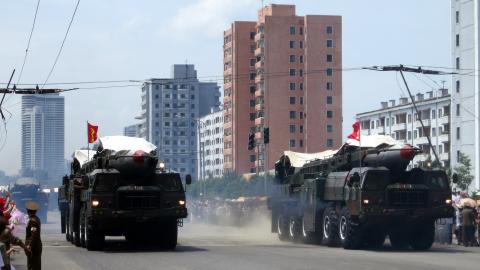Since President Joe Biden assumed office in January 2021, North Korea has ended its provocation pause and test-launched more missiles than ever, aiming to perfect its means of attacking the United States and its allies with nuclear weapons. The United States and its partners have strived to parry these threats through enhanced diplomacy, sanctions, deterrence, and a combination of offensive and defensive military capabilities.
Reaching New Heights
The Democratic People’s Republic of Korea (DPRK) has resumed testing its intercontinental ballistic missiles (ICBMs), which are designed to deliver a nuclear warhead against the United States. On February 18, the DPRK simulated a short-notice launch of its Hwasong-15 ICBM, rehearsing how to initiate nuclear strikes before the United States and its allies fully mobilize their defenses. The missile flew deep into outer space, more than a dozen times higher than the International Space Station. It could have landed anywhere in the United States if launched on a flatter trajectory.
This test is further evidence that the DPRK missile arsenal is increasing in quantity and improving in quality. Since it began its “turbocharged testing spree” last year, the North launched more nuclear-capable missiles than in any previous year. Many of these launches displayed innovative techniques and technologies intended to negate existing U.S. and allied defenses, such as using many missiles concurrently to overwhelm defenders, launching missiles from rail-mobile and submarine-based platforms, and employing hypersonic glide technologies that enable the warhead’s reentry vehicle to maneuver while descending on a target.
At the same time, the DPRK’s leader, Kim Jong-un, has declared his country’s nuclear status to be “irreversible.” Furthermore, the DPRK adopted a new law that may authorize DPRK field commanders to launch preemptive nuclear strikes and automatic retaliatory attacks if Kim is de-capitated. Additional enhancements to the DPRK missile arsenal are coming. In December 2022, Kim called for an “exponential” augmentation in the country’s weaponry, including serial manufacture of tactical nuclear weapons, reconnaissance satellites to assist with long-range missile strikes, and ICBMs intended for rapid counterstrikes against U.S. targets. Having resumed fissile material production, the DPRK might have several hundred nuclear-armed missiles by the end of this decade.
Missile Motives
Pyongyang pursues nuclear-armed missiles for power, prestige, and profits. The missiles aim to deter and, if necessary, defeat the United States and its allies, boost the North’s status and global attention, distract foreign and domestic observers from the DPRK’s economic and political flaws, and enhance the North’s leverage for extracting money and other Western concessions.
In peacetime, the North can leverage its missiles to coerce concessions from the United States and its allies. In a conflict, they provide the DPRK with a shield behind which to wage aggressive regional wars. Following the Russian playbook in Ukraine, Pyongyang’s policymakers might aspire to attack another country and then brandish its nuclear arsenal to deter a U.S. military response. American officials have acknowledged that possibility could weaken Washington’s extended deterrence guarantees to protect its Asian allies like Japan and South Korea. The DPRK wants these countries to doubt U.S. pledges to protect them—inducing them to appease rather than resist the North’s demands.
Fruitlessly Unconstrained
Three decades of negotiations, sanctions, and military countermeasures have failed to induce North Korea to relinquish its nuclear weapons aspirations. Past efforts to convince North Koreans that they would be more secure without nuclear weapons, offering the DPRK security assurances and confidence-building measures, or dangling visions of wealth and international acceptance have all proved insufficiently enticing. The DPRK has dismissed the Biden administration’s offers to resume direct talks despite proposals for “calibrated” diplomatic measures to decrease tensions with the North, dispel misperceptions that the United States threatens the DPRK, and facilitate North Korea’s return to compliance with its nuclear obligations.
The many sanctions adopted by the international community have restricted DPRK imports and exports, contributed to the isolation of the DPRK leadership, and constrained the North’s financial resources, but they have not halted the North’s missile development programs. Beijing and Moscow no longer enforce many existing sanctions and refuse to adopt new ones. Chinese and Russian leaders see DPRK provocations as mischievously helpful for distracting the United States from focusing on Beijing and Moscow.
Spurring Proliferation
The credibility of U.S. pledges to defend South Korea and Japan with all possible means, including U.S. nuclear weapons, was weakening even before the DPRK’s recent provocations. For several years, opinion polls indicate that most South Koreans want to acquire their own nuclear weapons or induce Washington to return U.S. nuclear weapons to South Korea. Some Japanese leaders have also more openly discussed their country’s nuclear weapons options in recent years. These views plausibly reflect the belief that the North will never abandon its nuclear weapons while the United States might prove unwilling to use its nuclear forces against North Korea if the DPRK could retaliate with nuclear strikes against U.S. territory.
U.S. officials and analysts have discouraged allies from pursuing nuclear weapons for fears of legitimizing the DPRK’s nuclear arsenal, spurring further nuclear proliferation, promoting regional arms races, and decreasing crisis stability. By seeking nuclear weapons, Japan and South Korea would antagonize the United States and other governments, demean their countries’ lofty international reputations, expose themselves to economic sanctions, and intensify first-strike incentives in a crisis. Instead, the United States has assisted its allies to enhance their missile defenses, damage limitation, and other non-nuclear capabilities.
Furthermore, the Biden administration made bolstering the credibility of U.S. extended security guarantees to these Asian partners one of the highest priorities of the recently completed U.S. Nuclear Posture and Missile Defense Reviews. The first review explicitly warns that the United States will destroy the DPRK regime should it use nuclear weapons: “Any nuclear attack by North Korea against the United States or its Allies and partners is unacceptable and will result in the end of that regime.” The need to reassure allies like South Korea and Japan, which rely on U.S. nuclear weapons for defense against major non-nuclear as well as nuclear attacks, was a major factor leading the Biden administration to reject proposals to adopt a “sole-purpose” or “no-first-use” declaratory doctrine. Such a declaration would have committed the administration to employ nuclear weapons only after an aggressor country had used them against the United States.
Opportunities for Defense
Yet, there is no attractive offensive military option available to the United States. Even with U.S. nuclear forces, a limited preemptive strike may not destroy all DPRK weapons of mass destruction, which are widely dispersed in concealed and hardened facilities. A U.S. first strike could easily precipitate a conventional war on the Korean Peninsula even more destructive than the one seen in Ukraine. The United States and other defenders will attempt to disrupt North Korea’s missiles through cyber attacks, electronic warfare, and other non-kinetic means, but DPRK designers have enhanced their missiles from such vulnerabilities.
The Biden administration’s Missile Defense Review, therefore, insists that “the United States will also continue to stay ahead of North Korean missile threats to the homeland through a comprehensive missile defeat approach, complemented by the credible threat of direct cost imposition through nuclear and non-nuclear means.” These words echo those of the Trump administration’s Missile Defense Review, which affirmed that the United States would “continually improve [U.S.] defensive capabilities as needed to stay ahead of North Korean missile threats if they continue to grow, while also taking steps to preclude an arms race with China or Russia.” Following the most recent DPRK missile test, U.S. Representative Mike Rogers, Chairman of the House Armed Services Committee, released a statement affirming that “Protecting the U.S. homeland must be paramount as we develop our 2024 budget, and this includes fully-funding homeland missile defense assets.” Even imperfect missile defenses can help deter and defeat attacks by complicating a potential missile aggressor’s certainty of success. They can also reassure allies that they do not need nuclear weapons or to appease those who are threatening them.
The foundation of the U.S. homeland defense against DPRK missiles is the fleet of Ground-Based Interceptors (GBIs) in Alaska and California that underpin the Ground-Based Midcourse Defense architecture over North America. These multi-stage solid-fueled rocket boosters are equipped with an unarmed Exo-Atmospheric Kill Vehicle, that collides with a target in outer space, obliterating it with kinetic energy. Presently only a few dozen interceptors protect the continental United States from incoming ICBMs. Unfortunately, the United States rushed these GBIs into service in the early 2000s and has not yet comprehensively renewed them. Instead, they have received only patched upgrades and infrequent tests. At this point, the potential for further upgrading the original GBIs is limited given their decades-old technology, calling into question their efficacy of dealing with the North’s rapidly expanding capabilities.
The United States is, therefore, developing a Next Generation Interceptor (NGI) to provide a more reliable kill vehicle to address the expanding North Korean missile threat. Though an entirely new system built from the ground up, the NGI technology maturation plan aims for an evolutionary rather than revolutionary increase in capabilities. Its improved command, control, communications, and sensor capabilities will increase the system’s reliability. The NGI’s larger payload can carry more than one kill vehicle on each interceptor. Its greater propulsion than the GBI will bring the kill vehicles faster to their interception points, giving warfighters makers more time to make decisions, more opportunities to address complex threats, and more assured means of discriminating between decoys and genuine targets. With planned deployment by 2028, the NGI’s modularity and preplanned upgrades will enable the United States to address subsequent threats more rapidly and confidently.
The Missile Defense Agency, responsible for overseeing the systems requirements and design review for the interceptors, has admirably promoted competition between two contracting teams to accelerate the delivery timeline, drive down costs, and limit technical risk. Meeting this performance metric will require testing the GBI frequently in demanding scenarios, independently and in combination with other elements to enhance performance. For some of these enablers, it might be prudent for the Agency to accept more risks with technology development programs, such as those intended to thwart emerging threats like hypersonic missiles. The planned upgrades to the existing network of sensors, command-and-control nodes, cyber defenses, and other critical support systems will also make the current GBI fleet more effective, pending the eventual deployment of the NGI. Extending the NGI competition through a prototype fly-off would further ensure the fielding of the most capable interceptor.
To construct a multi-layered defense architecture against the DPRK’s ICBM-class targets that protects Hawaii and Guam as well as the Continental United States, the Pentagon will need to integrate the NGIs with regional missile defenses. In the Indo-Pacific region, these include the Aegis-equipped Standard Missile interceptors deployed on ships along with the land-based Patriot and Terminal High Altitude Area Defense systems. Besides protecting U.S. deployed forces and allies, these regional missile defenses can provide important warning and tracking data of ICBMs launched from North Korea toward the United States. The potential effectiveness of such local systems has been evident in Ukraine, where even less advanced regional missile defenses have worked well in blunting the Russian missile onslaught. A comprehensive global defense architecture could also help protect the United States and its allies and forces from missiles launched by other countries.
The long-term solution to the Korean crisis is internal regime change and reunification under a government that resembles present-day South Korea. Yet, no one knows how long this process could take given the ruthless effectiveness of the DPRK’s totalitarian regime. In the interim, having a robust spectrum of defense capabilities, suitable for a range of scenarios, is critical given the rapidly evolving threat environment.





















